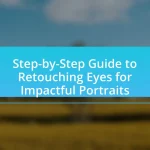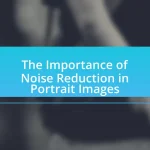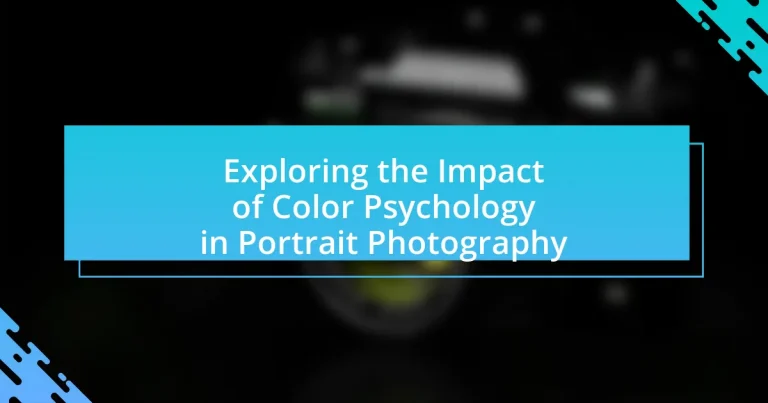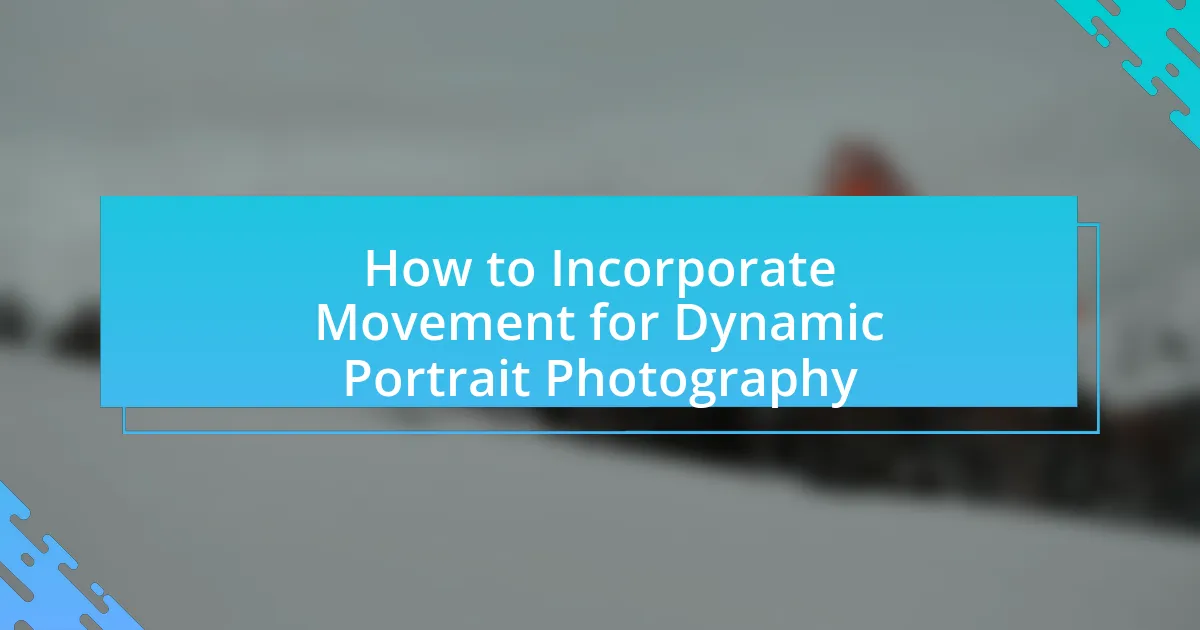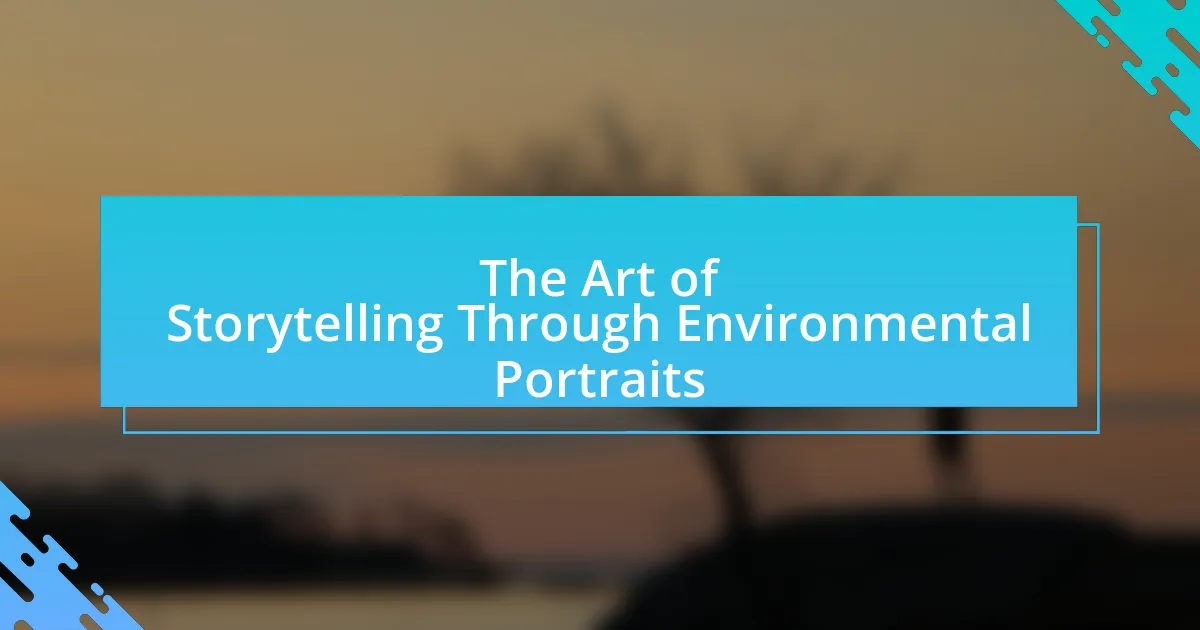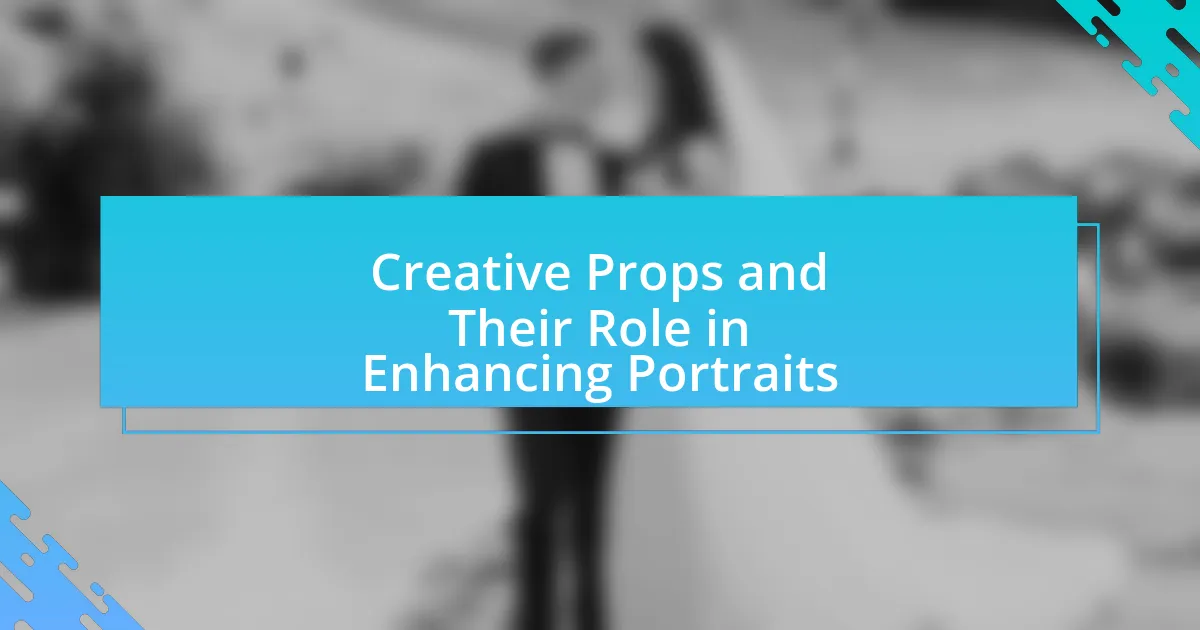The article explores the significant role of color psychology in portrait photography, emphasizing how color influences emotional responses and viewer perceptions of subjects. It discusses the psychological effects of different colors, the importance of understanding cultural contexts, and the principles of color harmony that can enhance portrait composition. Additionally, the article provides practical tips for photographers on how to effectively apply color psychology in their work, including techniques for color selection, lighting adjustments, and avoiding common mistakes. Overall, it highlights the impact of color choices on storytelling and emotional connection in portrait photography.

What is the role of color psychology in portrait photography?
Color psychology plays a crucial role in portrait photography by influencing the viewer’s emotional response and perception of the subject. Different colors evoke specific feelings; for instance, warm colors like red and orange can convey passion and energy, while cool colors like blue and green often evoke calmness and tranquility. Research indicates that colors can significantly affect mood and behavior, as demonstrated in studies such as those by Elliot and Maier (2014), which show that color can impact cognitive performance and emotional states. Therefore, understanding color psychology allows photographers to intentionally select hues that enhance the narrative and emotional depth of their portraits, ultimately shaping how the audience connects with the image.
How does color influence emotions in portrait photography?
Color significantly influences emotions in portrait photography by evoking specific feelings and associations. For instance, warm colors like red and orange can create a sense of warmth, passion, or excitement, while cool colors such as blue and green often evoke calmness, tranquility, or sadness. Research indicates that colors can trigger emotional responses; for example, a study published in the journal “Color Research and Application” found that people associate certain colors with specific emotions, such as happiness with yellow and anger with red. This understanding allows photographers to strategically use color to enhance the emotional impact of their portraits, guiding viewers’ feelings and interpretations of the subject.
What are the psychological effects of different colors?
Different colors evoke specific psychological effects that can influence emotions and behaviors. For example, red often stimulates feelings of excitement and passion, while blue tends to promote calmness and tranquility. Yellow is associated with happiness and optimism, whereas green is linked to nature and balance. Research indicates that these associations can affect decision-making and mood; for instance, a study published in the journal “Color Research and Application” by Andrew J. Elliot and Markus A. Maier found that red can enhance performance in detail-oriented tasks, while blue can foster creativity. Thus, understanding the psychological effects of colors is crucial in fields like portrait photography, where color choices can significantly impact the viewer’s emotional response.
How can color choices alter the viewer’s perception of a portrait?
Color choices significantly influence the viewer’s perception of a portrait by evoking specific emotions and associations. For instance, warm colors like red and orange can create feelings of warmth and passion, while cool colors such as blue and green often evoke calmness and tranquility. Research in color psychology indicates that colors can affect mood and behavior; for example, a study published in the journal “Color Research and Application” by Andrew Elliot and Markus Maier found that red can enhance feelings of excitement and energy, while blue can promote a sense of peace and reliability. Thus, the strategic use of color in portrait photography can shape how viewers emotionally connect with the subject, ultimately altering their overall interpretation and experience of the artwork.
Why is understanding color psychology important for photographers?
Understanding color psychology is important for photographers because it influences the emotional response of viewers to images. Photographers can use specific colors to evoke feelings such as warmth, calmness, or excitement, thereby enhancing the narrative and impact of their portraits. For instance, research indicates that colors like blue can create a sense of tranquility, while red can evoke passion or urgency. By strategically applying color psychology, photographers can effectively communicate their intended message and connect with their audience on a deeper emotional level.
How can color psychology enhance storytelling in portraits?
Color psychology enhances storytelling in portraits by influencing viewers’ emotions and perceptions through the strategic use of color. For instance, warm colors like red and orange evoke feelings of warmth and passion, while cool colors such as blue and green can convey calmness or sadness. Research indicates that colors can significantly affect mood and interpretation; for example, a study published in the journal “Color Research and Application” found that color can alter emotional responses and perceptions of personality traits. By selecting specific colors that align with the narrative intent, photographers can create a deeper emotional connection and convey complex stories within a single image.
What impact does color have on the subject’s representation?
Color significantly influences the representation of a subject in portrait photography by evoking emotional responses and shaping perceptions. For instance, warm colors like red and orange can convey energy and passion, while cool colors such as blue and green often evoke calmness and tranquility. Research indicates that colors can affect viewer interpretation; a study published in the Journal of Experimental Psychology found that subjects perceived individuals wearing red as more attractive and dominant compared to those in blue. This demonstrates that color not only enhances aesthetic appeal but also alters the viewer’s emotional connection and interpretation of the subject’s personality.
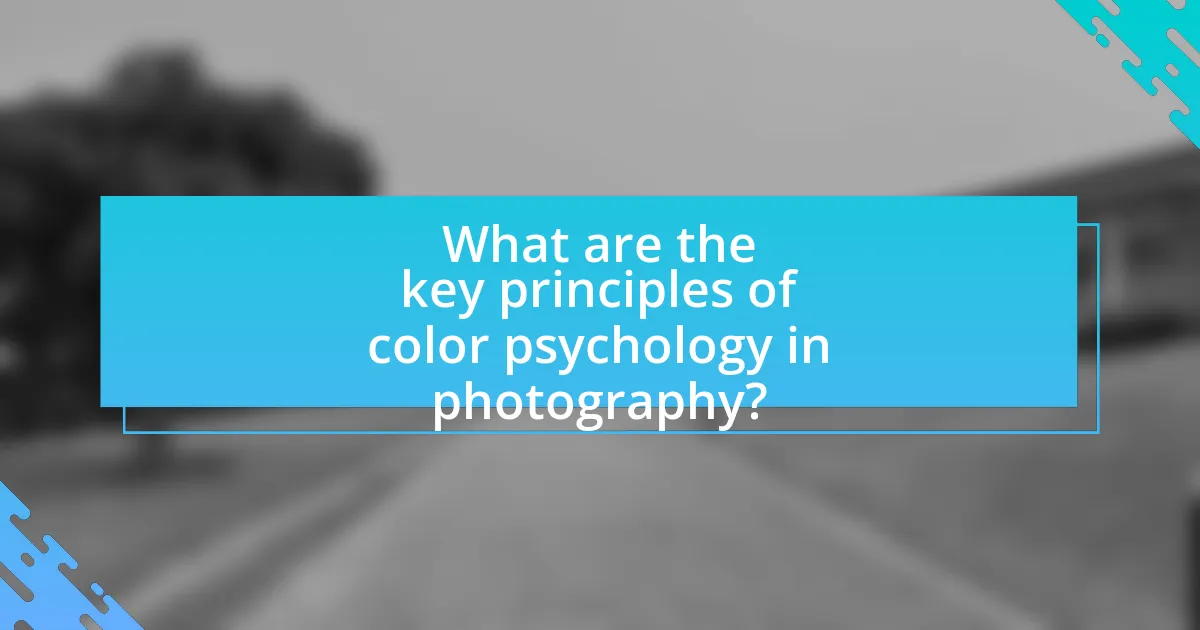
What are the key principles of color psychology in photography?
The key principles of color psychology in photography include the emotional impact of colors, color harmony, and cultural associations. Emotional impact refers to how different colors evoke specific feelings; for example, red can signify passion or urgency, while blue often conveys calmness and trust. Color harmony involves the combination of colors that create a visually appealing image, such as complementary colors that enhance each other. Cultural associations highlight how colors can have different meanings across various cultures, influencing viewer perception. For instance, white symbolizes purity in Western cultures but can represent mourning in some Eastern cultures. These principles guide photographers in creating images that resonate emotionally and culturally with their audience.
How do color harmonies affect portrait composition?
Color harmonies significantly influence portrait composition by creating visual balance and emotional resonance. When colors are harmonized, they can enhance the subject’s features and evoke specific feelings, guiding the viewer’s emotional response. For instance, complementary colors can create contrast that draws attention to the subject, while analogous colors can produce a serene and cohesive look. Research in color theory indicates that harmonious color schemes can improve aesthetic appeal and viewer engagement, as seen in studies by researchers like Johannes Itten, who emphasized the psychological effects of color combinations in art.
What are the different types of color harmonies used in photography?
The different types of color harmonies used in photography include complementary, analogous, triadic, split-complementary, and monochromatic color harmonies. Complementary color harmony involves using colors that are opposite each other on the color wheel, creating high contrast and vibrant images. Analogous color harmony consists of colors that are next to each other on the color wheel, resulting in a serene and comfortable aesthetic. Triadic color harmony employs three colors that are evenly spaced around the color wheel, offering a balanced yet dynamic composition. Split-complementary color harmony combines one base color with the two colors adjacent to its complementary color, providing contrast while maintaining harmony. Monochromatic color harmony utilizes variations in lightness and saturation of a single color, creating a cohesive and unified look. These color harmonies are essential in photography as they influence the emotional response of viewers and enhance the overall visual impact of the images.
How can photographers effectively use complementary colors?
Photographers can effectively use complementary colors by strategically pairing colors that are opposite each other on the color wheel, such as blue and orange or red and green, to create visual contrast and enhance the emotional impact of their portraits. This technique draws attention to the subject, as complementary colors can make the focal point stand out against the background, thereby increasing visual interest. Research in color theory indicates that complementary colors can evoke strong emotional responses; for instance, blue can convey calmness while orange can evoke warmth, creating a dynamic interplay that enhances the overall mood of the photograph.
What role does cultural context play in color interpretation?
Cultural context significantly influences color interpretation by shaping the meanings and associations individuals attribute to specific colors. For instance, in Western cultures, white is often associated with purity and weddings, while in many Eastern cultures, it symbolizes mourning and funerals. This divergence illustrates how cultural backgrounds dictate emotional responses and perceptions of color, impacting artistic choices in portrait photography. Research by the International Journal of Color Science and Technology highlights that color meanings can vary widely across cultures, reinforcing the necessity for photographers to understand their audience’s cultural context to effectively convey intended messages through color.
How do cultural differences influence color meanings?
Cultural differences significantly influence color meanings, as colors can evoke distinct emotions and associations based on cultural context. For instance, in Western cultures, white is often associated with purity and weddings, while in many Eastern cultures, it symbolizes mourning and funerals. This divergence in color interpretation is supported by studies such as “Cultural Differences in Color Meaning” by H. A. H. Alghamdi, which highlights how cultural backgrounds shape perceptions of colors. Understanding these variations is crucial in fields like portrait photography, where the choice of color can impact the viewer’s emotional response and interpretation of the subject.
What should photographers consider regarding cultural perceptions of color?
Photographers should consider that cultural perceptions of color significantly influence how their work is interpreted by diverse audiences. Different cultures attribute varying meanings to colors; for example, white symbolizes purity and peace in Western cultures, while in some Eastern cultures, it represents mourning and death. Understanding these associations can help photographers avoid miscommunication and enhance the emotional impact of their images. Research indicates that color perception is deeply rooted in cultural context, as demonstrated by studies showing that colors can evoke distinct emotional responses based on cultural backgrounds. Therefore, photographers must be aware of these cultural nuances to effectively convey their intended messages through color in portrait photography.
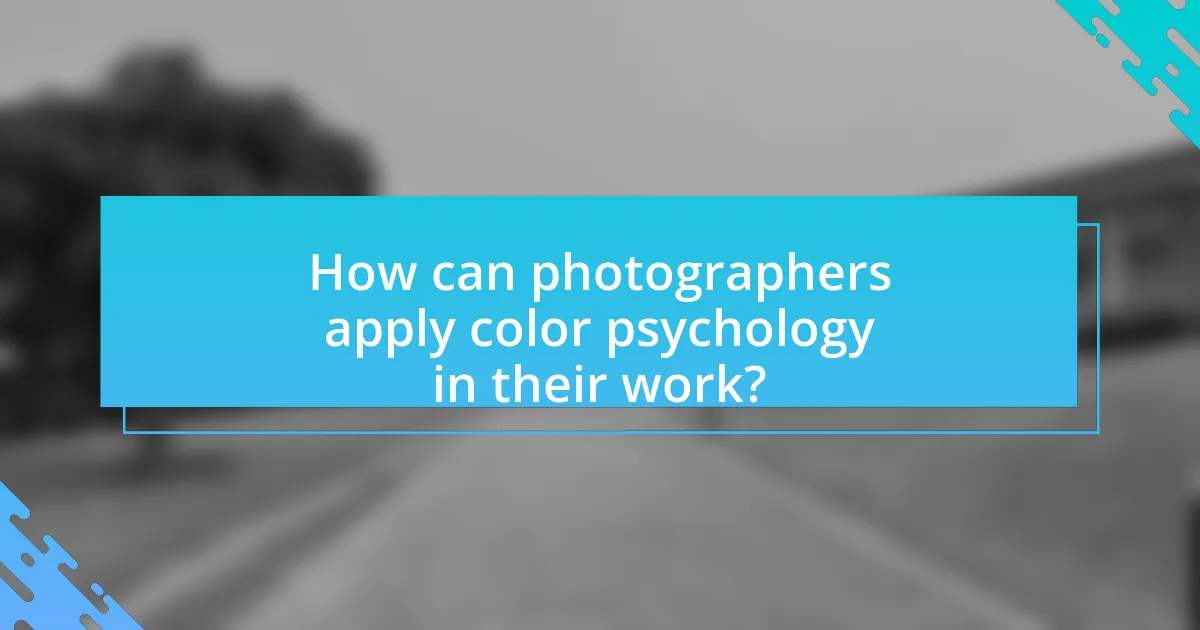
How can photographers apply color psychology in their work?
Photographers can apply color psychology in their work by intentionally selecting colors that evoke specific emotions and responses from viewers. For instance, warm colors like red and orange can create feelings of warmth and excitement, while cool colors such as blue and green can evoke calmness and tranquility. Research indicates that colors can significantly influence perception; for example, a study published in the journal “Color Research and Application” found that people associate certain colors with specific feelings, such as blue with trust and red with passion. By understanding these associations, photographers can enhance the emotional impact of their portraits, guiding the viewer’s experience and interpretation of the image.
What techniques can be used to incorporate color psychology in portrait photography?
To incorporate color psychology in portrait photography, photographers can utilize techniques such as color selection, lighting adjustments, and background choices. Color selection involves choosing hues that evoke specific emotions; for example, blue can convey calmness, while red can evoke passion. Lighting adjustments can enhance the emotional impact of colors; soft lighting can create a warm atmosphere, while harsh lighting can emphasize stark contrasts. Background choices also play a crucial role; using colors that complement the subject’s attire can enhance the overall mood of the portrait. Research indicates that colors can significantly influence perception and emotional response, supporting the effectiveness of these techniques in portrait photography.
How can lighting affect color perception in portraits?
Lighting significantly affects color perception in portraits by altering the way colors are rendered and perceived by the viewer. Different lighting conditions, such as natural light, artificial light, or colored gels, can enhance or diminish specific hues, impacting the overall mood and emotional response elicited from the portrait. For instance, warm lighting can make skin tones appear more vibrant and inviting, while cool lighting can create a more subdued and dramatic effect. Studies in color theory indicate that the color temperature of light influences how colors are interpreted; for example, daylight (around 5500K) tends to render colors more accurately compared to tungsten light (around 3200K), which can cast a yellowish tint. This understanding is crucial for photographers aiming to convey specific emotions or themes through their work.
What are some effective color palettes for different portrait styles?
Effective color palettes for different portrait styles include warm tones, cool tones, and monochromatic schemes. Warm tones, such as reds, oranges, and yellows, evoke feelings of energy and warmth, making them suitable for lively and engaging portraits. Cool tones, including blues, greens, and purples, create a calming effect, ideal for serene and introspective portraits. Monochromatic schemes, which utilize varying shades of a single color, can convey a strong emotional impact and create a cohesive look. Research in color psychology indicates that colors can significantly influence mood and perception, supporting the effectiveness of these palettes in portrait photography.
What common mistakes should photographers avoid when using color psychology?
Photographers should avoid using colors that clash or create visual discomfort, as this can detract from the intended emotional impact of the portrait. For instance, using overly saturated colors without considering the subject’s skin tone can lead to unflattering results. Additionally, neglecting the cultural meanings of colors can result in misinterpretation; for example, red may symbolize love in some cultures but signify danger in others. Furthermore, failing to create a cohesive color palette can confuse the viewer and dilute the message of the photograph. Research indicates that color can influence perception and emotional response, highlighting the importance of thoughtful color choices in photography.
How can over-saturation impact the emotional tone of a portrait?
Over-saturation can significantly alter the emotional tone of a portrait by intensifying colors, which may evoke stronger feelings or create a sense of artificiality. When colors are overly saturated, they can lead to heightened emotions such as excitement or aggression, while also risking the loss of subtlety and realism in the subject’s expression. Research in color psychology indicates that vibrant colors can stimulate emotional responses; for instance, red can evoke passion or anger, while blue can induce calmness. Therefore, the degree of saturation directly influences how viewers perceive and emotionally connect with the portrait.
What are the pitfalls of ignoring color theory in portrait photography?
Ignoring color theory in portrait photography can lead to unflattering images that fail to convey the intended mood or emotion. When photographers neglect color harmony, they risk creating portraits that clash visually, resulting in a disjointed aesthetic that distracts from the subject. For instance, using colors that do not complement the subject’s skin tone can create an unnatural appearance, making the subject look washed out or overly saturated. Additionally, poor color choices can miscommunicate the emotional tone of the photograph; for example, warm colors typically evoke feelings of comfort and happiness, while cool colors can suggest sadness or detachment. Research in color psychology indicates that colors significantly influence viewer perception and emotional response, underscoring the importance of applying color theory effectively in portrait photography.
What practical tips can enhance the use of color psychology in portrait photography?
To enhance the use of color psychology in portrait photography, photographers should carefully select color palettes that evoke specific emotions and messages. For instance, warm colors like red and orange can convey energy and passion, while cool colors such as blue and green often evoke calmness and tranquility. Additionally, understanding color harmony is crucial; complementary colors can create visual interest, while analogous colors can produce a more cohesive and soothing effect.
Moreover, the context of the portrait matters; colors should align with the subject’s personality and the intended mood of the photograph. For example, using softer pastels can enhance a gentle or romantic theme, while bold, saturated colors can emphasize strength and confidence.
Research indicates that color can significantly influence perception; a study published in the journal “Color Research and Application” found that colors can affect emotional responses and even decision-making processes. Therefore, applying these principles of color psychology can lead to more impactful and resonant portrait photography.
How can photographers experiment with color to find their unique style?
Photographers can experiment with color by utilizing various color palettes, adjusting saturation and contrast, and incorporating different lighting conditions to discover their unique style. By exploring complementary and analogous color schemes, photographers can create visually striking images that resonate with their artistic vision. Research indicates that color influences emotions and perceptions; for instance, warm colors can evoke feelings of warmth and comfort, while cool colors may convey calmness or sadness. This understanding allows photographers to intentionally select colors that align with the mood they wish to portray, thereby enhancing their personal style.
What resources are available for learning more about color psychology in photography?
Books, online courses, and academic articles are valuable resources for learning about color psychology in photography. Notable books include “Color Psychology in Art” by Andrew W. Melrose, which explores the emotional impact of color in visual arts, including photography. Online platforms like Coursera and Udemy offer courses specifically focused on color theory and its application in photography, providing structured learning experiences. Additionally, academic journals such as the “Journal of Color Research and Application” publish peer-reviewed articles that delve into the psychological effects of color, offering empirical evidence and insights relevant to photographers. These resources collectively enhance understanding of how color influences perception and emotion in portrait photography.




